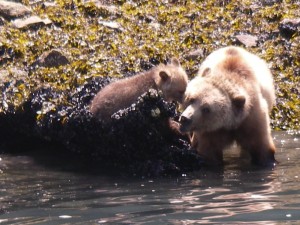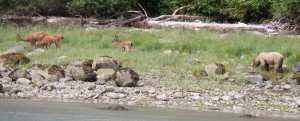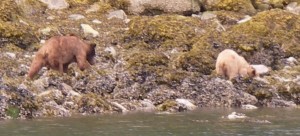 This is a sequence of pictures from late July last year. The darker male grizzly bear was so thin that you could count his ribs but he was not into eating. Although most of the mating takes place in May and June this bear has a one-track mind. Mating is a highly evolved ritual. Once females come into season, they may leave scent trails, and male bears quickly hone in on the scent….more tomorrow.
This is a sequence of pictures from late July last year. The darker male grizzly bear was so thin that you could count his ribs but he was not into eating. Although most of the mating takes place in May and June this bear has a one-track mind. Mating is a highly evolved ritual. Once females come into season, they may leave scent trails, and male bears quickly hone in on the scent….more tomorrow.
Tag Archives: Grizzly Bears
Warm as a bathtub?
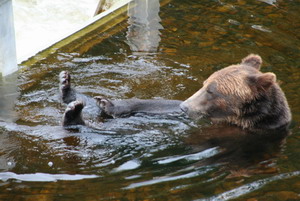
One of the viewing platforms used on the fall Grizzly Bear Canada tours is opposite the weir that acts as an entrance to the spawning channel. We normally use the finger stand as it has more of the natural river and does not show the weir in the background but occasionally we stop and check out the weir. On this day there was a grizzly just relaxing, not a care in the world. “Little more privacy please, no flashes.”
June Grizzly and Cub
This was a good day with the bears. This is a common scene in the spring when mothers bring their cubs to the beach to feed. The run up Knight Inlet on the grizzly bear tour day to the Glendale River estuary is 40 km (26 m) and the last 5 km (3 m) is often referred to as the nursery. The mother grizzlies bring their cubs to this area to avoid the larger males in Glendale Cove. Remember grizzly mating season runs from May to early July and this places new cubs in danger.
Friends? (1 of 2)
Most of the grizzly watching tours from the lodge arrive at the River estuary on Knight Inlet and view the coast black tail deer. The sedge grass is high in protein and provides an excellent food for both deer and grizzly bears. It is the main food sources for grizzlies along with the protein from turning of rocks. The three male deer on the beach with a young grizzly seem to be keeping their distance for a quick get-away.
Grizzly Bear Triplets
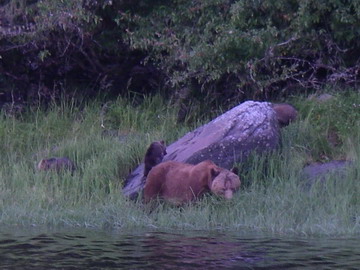
Note that there are three cubs: to the left of the rock, on the rock and to the right (partially hidden by the rock). We watched this family for about an hour and I was not able to get a clear photo of the family together. My guest got good photos but then they were not maneuvering the boat and taking pictures. That’s my excuse. Grizzly cubs, twins and triplets, are not uncommon in the area of Knight Inlet. It is a sign that the females are healthy and able to handle multiple births. The cubs are born in the winter den and if the female is not in good health (enough fat to feed her and her expected babies) the eggs are absorbed and no cubs are produced. Many of these multiple births survive their first year as they are seen the following year still with their mothers.
June Bears
In late May and early June the grizzlies show up in the Glendale River estuary and along the shores on Knight Inlet. They have come out of hibernation having lost a significant amount of their body fat and are looking for food. Some bears are in much better shape, after a long winter, than other bears. This male grizzly is in good shape and ready for the breeding which takes place at this time of the year. He is also the reason the mother grizzlies keep their cubs away from the river estuary.
September Viewing Platform
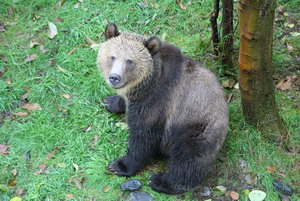
Click photo to enlarge then click again
This fat two-year-old cub came to visit beneath the viewing platform this past September. After August 24th the grizzly bear tours from the lodge use one of two viewing platforms located on Knight Inlets Glendale River. The bears in the area have come to accept our presence and as long as we avoid loud noises, flashes on cameras and sudden movement we are ignores. This does not mean that on occasion such as this a grizzly will not come and watch use for a while.
Salmon have arrived
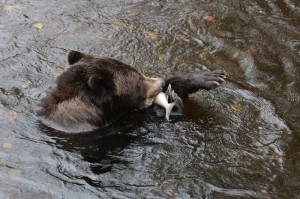
This appears to be an awkward pose, with one paw out straight, for a grizzly bear eating a salmon. This is one of the few bears that we have seen over the years that were injured in a fight. The front paw could not bare weight but this bear became an excellent fisher and was able to catch salmon and fatten for the winters denning. When last viewed in October this grizzly appeared to have put on enough fat to survive hibernation but next year will tell the story if it is back at the river.
Spring grizzlies roll rocks
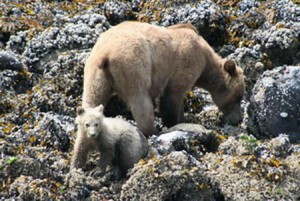
By late May grizzly bears and cubs are starting to appear on the beaches to turnover rocks. The inter-tidal zone “food” is high in protein and contains crab, clams, barnacles, amphipods and other tiny invertebrates. The “beach food” is important because plant food is relatively scarce during spring as berries do not become part of the diet until July and bears will continue to loose weight until well into June. The cubs rely on mother’s milk that is better than 30% fat. Mother bears tend to be affectionate, protective, devoted, strict, sensitive and attentive toward their cubs, raising them to an age where they can survive on their own. In return the cubs at this age do not stray far from their mother’s side.
Side effects of tapeworms
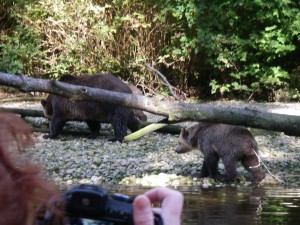
This was a close encounter with a mother grizzly and two cubs on Knight Inlet’s Glendale River. Going up river in our skiff with four guests we met the bears coming down. I pulled the skiff to opposite side of the river to allow them to pass about fifteen meters (yards) away. No we were not in danger, as this seemed to be this family’s routine over a two-week period and they had become accustomed to the ritual. As can be seen toward the end of summer and into fall, bears sometimes shed a type of tapeworm, commonly called the broad fish tapeworm. As this photo shows it can sometimes be seen trailing behind them. Grizzly bears can become infected by the tapeworm from eating raw salmon. The physical effect of bears harbouring tapeworm parasites is insignificant to the bear’s health. This will slightly stress the bear, but generally it is not advantageous for the parasite to kill the host, since that would also result in the death of the parasite. This was the only bear I saw with a tapeworm last summer.
